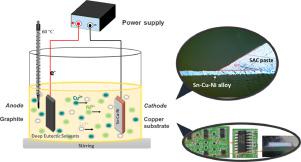Electrochimica Acta ( IF 5.5 ) Pub Date : 2021-10-02 , DOI: 10.1016/j.electacta.2021.139339 Sabrina Patricia Rosoiu 1 , Stefania Costovici 1 , Calin Moise 1 , Aurora Petica 1 , Liana Anicai 1, 2 , Teodor Visan 1, 3 , Marius Enachescu 1, 4

|
The paper presents several experimental results regarding the electrodeposition of Sn-Cu-Ni ternary alloys as an attractive lead-free solder candidate, involving deep eutectic solvents (DESs), namely using choline chloride-ethylene glycol and choline chloride-malonic acid eutectic mixtures. The influence of the metallic ions concentration in the electrolyte and of the applied current density on the Sn-Cu-Ni alloy composition and morphology has been investigated, in order to achieve the corresponding alloy composition (Sn99.4Cu0.6 alloy + Ni) able to possess the eutectic or near eutectic melting temperature of about 227 °C. Adherent, bright and uniform Sn-Cu-Ni alloy deposits have been obtained onto Cu substrate from choline chloride-ethylene glycol-based electrolytes for applied current densities between 5–8 mA.cm−2 at 60 °C. According to the TGA measurements, values of melting point of 229 °C have been obtained, corresponding to an alloy stoichiometry of Sn99.29-Cu0.65-Ni0.06 as indicated by EDX elemental analysis. In addition, analysis of the current-time curves using the Scharifker-Hills’ model suggested that the alloy deposition process corresponds to a nucleation and tridimensional growth controlled by diffusion mostly under instantaneous nucleation. Preliminary results related to the solder joints behavior showed adequate solderability characteristics and adhesion to the substrate with no fractures. Moreover, the electrodeposited Sn-Cu-Ni (Sn99.29-Cu0.65-Ni0.06) alloy coatings exhibited a slightly better corrosion performance as compared to Sn-Ni alloys electrodeposited from DESs and to the metallurgically prepared lead-free solders possessing a relatively similar composition.
中文翻译:

使用深共晶溶剂电沉积三元 Sn-Cu-Ni 合金作为无铅焊料
本文介绍了关于电沉积 Sn-Cu-Ni 三元合金作为有吸引力的无铅候选焊料的几个实验结果,涉及深共晶溶剂 (DESs),即使用氯化胆碱-乙二醇和氯化胆碱-丙二酸共晶混合物。研究了电解液中金属离子浓度和施加的电流密度对 Sn-Cu-Ni 合金成分和形貌的影响,以获得相应的合金成分(Sn99.4Cu0.6 合金 + Ni)具有约227°C的共晶或近共晶熔化温度。已从氯化胆碱-乙二醇基电解质中在 Cu 基板上获得了附着力、光亮和均匀的 Sn-Cu-Ni 合金沉积物,施加的电流密度在 5-8 mA.cm -2之间在 60°C。根据 TGA 测量,已获得 229 °C 的熔点值,对应于 EDX 元素分析表明的 Sn99.29-Cu0.65-Ni0.06 合金化学计量。此外,使用 Scharifker-Hills 模型对电流-时间曲线的分析表明,合金沉积过程对应于主要在瞬时成核下由扩散控制的成核和三维生长。与焊点行为相关的初步结果显示出足够的可焊性特性和对基板的附着力,没有断裂。此外,电沉积的 Sn-Cu-Ni (Sn99.29-Cu0.65-Ni0.











































 京公网安备 11010802027423号
京公网安备 11010802027423号